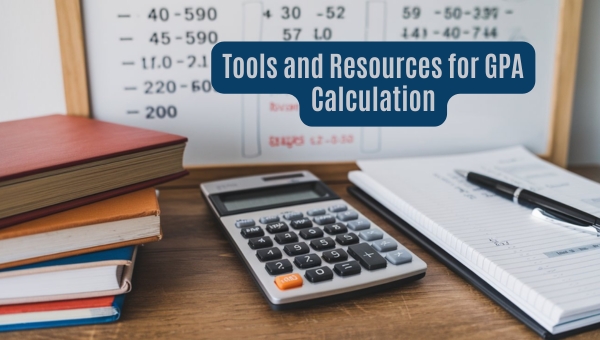How to Calculate GPA Easily: Step-by-Step Guide

Calculating your GPA can seem tricky, but it doesn’t have to be. In this article, you’ll discover how to calculate GPA in a few simple steps. We’ll cover gathering your grades, assigning grade points, and factoring in credit hours.
Plus, we’ll discuss common challenges and share tools and resources to make the process easier. Whether you’re aiming to boost your GPA or simply understand how it’s calculated, this guide has you covered. Dive in to ensure you’re on track for academic success!
Steps to Calculate Your GPA
Calculating your GPA can seem tricky, but it becomes straightforward when broken down into manageable steps. By following a systematic approach, you can easily determine your GPA and understand where you stand academically.

Let’s break down the process into three essential steps: gathering your grades, assigning grade points, and multiplying by credit hours.
a.) Gather Your Grades
First and foremost, you need to collect all your grades from various courses. This is the foundation of calculating your GPA.
To do this effectively:
- Access Your Academic Records: Log in to your school’s online portal or check your report cards to find your grades for each course.
- List Your Courses: Write down all the courses you have taken in a specific semester or academic year.
- Note the Grades: Next to each course, note the corresponding letter grade you received (e.g., A, B, C).
- Organize Your Data: Create a table or spreadsheet to keep this information organized. This will help you easily reference and calculate your GPA later.
Having all your grades in one place makes it much easier to move on to the next step.
b.) Assign Grade Points
Once you have your grades organized, the next step is to convert these letter grades into grade points using a standard scale. Typically, schools use a 4.0 scale, where each letter grade corresponds to a certain number of points:
- A = 4.0
- B = 3.0
- C = 2.0
- D = 1.0
- F = 0.0
Here’s how you can assign grade points:
- Identify the Scale: Confirm that your school uses the standard 4.0 scale or check if there’s a different scale in use.
- Convert Each Grade: For each course, convert the letter grade into its equivalent grade point. For example, if you received an A in Math, it converts to 4.0.
- Record the Points: Note down the grade points next to the corresponding courses in your table or spreadsheet.
This step translates your letter grades into a numerical format that can be used in calculations.
c.) Multiply by Credit Hours
The final step involves factoring in the credit hours for each course, as not all courses carry the same weight. Courses with more credit hours have a greater impact on your GPA. Follow these steps:
- List Credit Hours: Next to each course in your table, write down the number of credit hours it is worth.
- Multiply Grade Points by Credit Hours: For each course, multiply the grade point by the number of credit hours. For example, if you received a B (3.0) in a course worth 4 credit hours, the calculation would be 3.0 x 4 = 12.
- Sum the Results: Add up all the results from your calculations in the previous step to get a total grade point value.
- Sum the Credit Hours: Add up the total number of credit hours for all courses.
- Calculate GPA: Finally, divide the total grade point value by the total number of credit hours. The result is your GPA.
By following these steps, you can accurately calculate your GPA and gain a clear picture of your academic performance.
Common Challenges and Tips
Navigating the process of calculating your GPA can come with its own set of challenges. From dealing with different grading scales to handling incomplete or failed courses, it’s crucial to understand these obstacles to ensure an accurate GPA calculation. Let’s delve into some common challenges and tips to address them.

Dealing with Different Grading Scales
One of the most confusing aspects of calculating your GPA is dealing with varying grading scales. Different schools or regions might use different systems, making it hard to standardize your grades.
Here’s how you can manage this:
- Identify the Grading Scale: Determine if your school uses a 4.0, 5.0, or 10.0 scale. This information is usually found on your report card or school website.
- Convert Grades: Use a conversion table to translate grades from one scale to another. For example, an A in a 4.0 scale is equivalent to a 90-100% score.
- Consult School Resources: Reach out to academic advisors or school counselors for help with conversions.
- Stay Consistent: Once you’ve chosen a scale to use, apply it consistently across all courses to avoid errors.
Handling Incomplete or Failed Courses
Incomplete or failed courses can significantly impact your GPA, and understanding how to handle them is vital.
Here’s a detailed approach:
- Understand School Policies: Each institution has specific rules on how incomplete or failed courses affect GPA. Familiarize yourself with these policies.
- Incomplete Courses: Often, incomplete courses are temporarily excluded from GPA calculations until completed. Check how your school handles this.
- Failed Courses: Failed courses typically count as zero points in GPA calculations. It’s important to know if retaking the course can replace the failing grade.
- Impact Assessment: Calculate how incomplete or failed courses change your GPA by inputting different scenarios into a GPA calculator.
- Academic Support: Seek tutoring or academic support to complete incomplete courses or improve future grades.
By understanding these common challenges and employing these tips, you can navigate the complexities of GPA calculation more effectively.
Tools and Resources for GPA Calculation
When it comes to calculating your GPA, having the right tools and resources can make the process much easier. Whether you’re a tech-savvy student or prefer more straightforward solutions, there are several options available to help you keep track of your academic progress. Let’s explore some of the most effective tools and resources you can use.

Online Calculators
Online calculators are a fantastic resource for quickly and accurately determining your GPA. These tools are easy to use and can save you a lot of time.
Here are some popular features of online GPA calculators:
- User-Friendly Interface: Most online calculators have a simple layout that makes it easy to enter your grades and credit hours.
- Instant Results: Once you input all the necessary information, the calculator provides your GPA immediately.
- Customization Options: Some calculators allow you to adjust for different grading scales or add extra points for honors and advanced placement courses.
Mobile Apps for Students
For students who are always on the go, mobile apps offer a convenient way to track grades and calculate GPA. These apps often come with additional features that can enhance your academic experience.
Here are a few key aspects:
- Grade Tracking: Many apps let you input grades as soon as you receive them, helping you stay up-to-date with your progress.
- GPA Calculation: Just like online calculators, these apps can quickly compute your GPA based on the grades and credit hours you enter.
- Notifications and Reminders: Some apps provide reminders for upcoming assignments and exams, ensuring you stay organized and on top of your studies.
By leveraging these tools and resources, you can simplify the GPA calculation process and focus more on achieving your academic goals.
Importance of Maintaining a Good GPA
Maintaining a good GPA can open many doors for students. From academic opportunities to long-term career benefits, a strong GPA can be a game-changer. Let’s explore how a solid GPA can impact your academic journey and future prospects.
Academic Opportunities
A high GPA is often a key factor when it comes to academic opportunities. Here are a few ways it can benefit you:
- Scholarships: Many scholarship programs require a minimum GPA for eligibility. A higher GPA increases your chances of receiving financial aid for your education.
- Honors Programs: Schools often have honors programs that offer advanced coursework and special recognition. Admission to these programs typically requires a strong GPA.
- Internships: Employers and institutions frequently look at GPA when selecting candidates for internships. A good GPA can make your application stand out.
Long-Term Benefits
The advantages of a strong GPA extend beyond your academic life. Here are some long-term benefits:
- College Admissions: Colleges and universities often consider GPA as a critical factor in their admissions process. A high GPA can improve your chances of getting into your desired institution.
- Job Prospects: Many employers use GPA as a criterion when hiring new graduates. A good GPA can make you a more attractive candidate in the job market.
- Career Growth: Over time, a solid academic record can contribute to career advancement opportunities, as it reflects your dedication and ability to succeed.
Maintaining a good GPA is not just about immediate academic success. It also sets a foundation for future opportunities and achievements, making it a crucial aspect of your educational journey.
Conclusion
Calculating your GPA is a straightforward process once you understand the steps involved. From gathering your grades to assigning grade points and factoring in credit hours, each step is crucial for an accurate calculation. By overcoming common challenges and utilizing available tools, you can effectively manage your GPA.
Maintaining a good GPA opens doors to numerous academic and career opportunities, making it well worth the effort. If you found this guide helpful, be sure to check out more educational content on our site to help you succeed in your academic journey!




